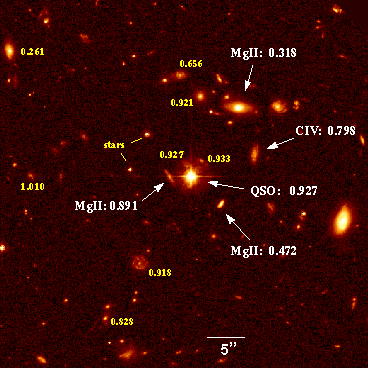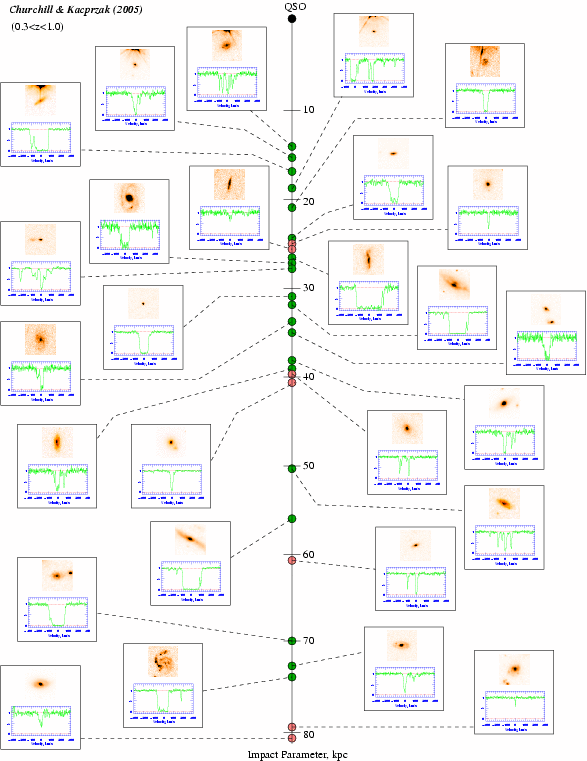Current Research InterestsChris ChurchillAssociate Professor of Astronomy GoalI study the role of gas in the evolution of galaxies. My goal is to obtain definitive observational data to constrain theories, models, and scenarios of galaxy evolution within the current paradigm of structure growth in the cosmic web. Experimental DesignQuasars are very distant highly luminous objects. Their light travels from the farthest reaches of the cosmos, throughout which gas and galaxies are peppered in a giant cosmic web structure. On its path to Earth, the quasar light probes the universe like a geological core sample of space and time. With each interaction with a cloud of gas, the dynamical motion of the gas and the chemical and ionization conditions are recorded in the patterns in the light. By obtaining the spectrum of the quasar, we can chart these patterns and study the conditions of the gas. These patterns are observed as absorption lines, as illustrated in Figure 1, below.

Fig. 1 --- An example of absorption lines in a quasar spectrum. the smooth flat portion is the quasar continuum. The absorption lines are the regions of missing light, which arise from various atoms in gas clouds.Galaxies have a large extended halos of gas surrounding them. If galaxies lie between us and the quasar and near the line of sight, then some of the galactic gas actually subtends directly in front of the quasar. The projected separation between galaxy and the quasar is called the impact parameter. Figure 2 (below) is an example of the imaging data use to obtain the properties of the galaxies and a schematic of the quasar light passing through the galaxies.


Fig. 2 --- (left panel) This is an HST image of the galaxy field around the quasar 3C 336, which is the bright object in the middle of the image labeled "QSO: 0.927". The redshift (proportional to distance) of this quasar is z = 0.927. There are many galaxies with lower redshifts, i.e., they are between us and the quasar. Four galaxies and their redshifts are labeled. --- (right panel) The light of the quasar (upper left) passes through the gas in a galaxy (green). The gas comprises several gas clouds, each with its own velocity (speed and direction, shown as blue arrows). The gas absorbs the quasar light which is observed in the spectrum (lower right). Each cloud absorbs light at different velocities. Sample of Galaxy-Absorber PairsOne important observational quantity is the "impact parameter", which is the projected separation between the quasar and the galaxy in the images. This is basically the distance out from the center of the galaxy that the gas is being sampled by the quasar light beam. Figure 3, below, is a diagram showing the galaxy-absorption pairs as a function of impact parameter.
Fig 3. --- Each panel is a a galaxy-absorprion pair. The images of the galaxies (2" x 2") were obtained with the Hubble Space Telescope. The spectra of the quasars were obtained with HIRES/Keck and UVES/VLT. The absorption (shown in green) is the MgII 2796 trasition presented in velocity spread (each panel covers 600 km/s). The coordinate system down the center of the diagram is the impact parameter, where the quasar sight line samples the halo of gas surrounding the galaxy. (Note: in the images at small impact parameter, the quasar acan be seen.) Tools of the TradeThe facilities mostly used are the HIRES on the Keck I telescope, the UVES on The Very Large Telescope, the STIS on the Hubble Space Telescope, and the IRCS on the Subaru telescope. Images of the quasar fields are also utilized in order to measure the properties of the galaxies. the facilities mostly used are the WFPC and ACS on Hubble and more recently SPIcam on the apache Point 3.5 meter telescope.
|
